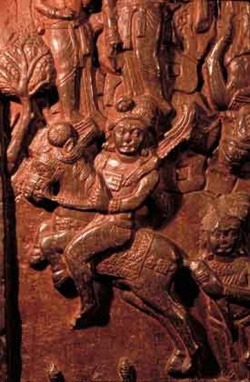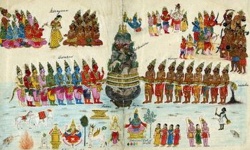Pañcasikha
Pañcasikha: A Gandhabba. His favourite instrument was the Beluvapanduvīnā. He was considered a favourite of the Buddha (DA.iii.699), and when Sakka visited the Buddha at the Indasālaguhā in order to ask him certain questions, he sent Pañcasikha in advance, that he might obtain permission for the interview. The episode in given in full in the Sakkapañha Sutta (D.ii.263ff.).
Pañcasikha approached the Buddha and playing on his vinā, sang of the beauties of the Buddha, the Doctrine, Arahants and Love. The verses really formed a love poem addressed to his beloved, Bhaddā Suriyavaccasā, daughter of the Gandhabba Timbarū. The Buddha praised his music and song and questioned him about the poem. He confessed that when the Buddha was staying under the Ajapāla nirgodha, before the Enlightenment, he (Pañcasikha) had met Suriyavaccasā going with her father to dance before Sakka. Pañcasikha thereupon fell in love with her; but she favoured the suit of Sikhandi, son of Mātali. Pañcasikha thereupon composed a song, which he sang to her. She was greatly pleased with the references in the song to the Sākiyan sage of whom she had heard when she went to the Sudhammāsabhā, (on this occasion Sakka, pronounced his 8 fold eulogy of the Buddha, contained in the Mahāgovinda Sutta, says Buddhaghosa, DA.ii.704) and she consented to marry Pañcasikha. It is said that Sakka blessed the marriage in return for Pañcasikha's intercession with the Buddha on his behalf.
In the Janavasabha Sutta (D.ii.211; also in the Mahāgovinda Sutta, D.ii.230) it is stated that when Brahmā Sanankumāra appeared before the assembly of the gods of Tāvatimsa and materialized himself he assumed the form of Pañcasikha. Buddhaghosa says (DA.ii.640), by way of explanation, that all the devas loved Pañcasikha and wished to resemble him. In the Mahāgovinda Sutta (D.i.220; cp. Mtu.iii.197ff) Pañcasikha is represented as conveying to the Buddha a full report of the happenings in the assembly of the devas, when Sakka spoke the Buddha's praises.
No really satisfactory explanation is found in the Commentaries of Pañcasikha's name. Buddhaghosa says (DA.ii.647) Pañcasikho ti pañcacūlo, pañcakundaliko, and goes on to say that Pañcasikha was born once as a human being, and, while yet a boy wearing his hair in five knots* (pañcacūlakadāraka kāle), he became chief of those who tended the calves.
* This is done even now in Ceylon, where young boys' hair is tied round their heads in several knots. But in one place (DA.i.296) Buddhaghosa says that one way of insulting a man was to shave his head, leaving him five locks of hair (garahāyā ti pañcasikhā mundakaranam). And, again (SA.i.171), he mentions that Sanankumāra retained his eternal youth because in a previous life he had developed jhāna while yet a lad (pañcasikhakumārakāle). See also J.vi.496, where a traitor had his hair tied in five knots as a sign of disgrace.
Together with other lads he engaged in works of public utility, such as repairing roads, digging wells, building rest houses, etc., and he died while young. He was reborn in the Cātummahārājika world, destined to live for ninety thousand years, his body three gāvutas in height. He wore on his person one hundred cartloads of ornaments and rubbed nine pots of perfume on his body. He wore red robes, and on his head a chaplet of red gold, round which his hair was arranged in five locks (kuntalikehi), which fell back as in the case of a young boy (pañcacūli-kadārakaparihāren'eva).
It was Pañcasikha who first received from the king of the Cātummahārājika worlds and their ministers reports of good deeds done by human beings. These he would pass on to Mātali, who, in his turn, presented them to Sakka (DA.ii.650). On the day of the Devārohana, when the Buddha descended from Tāvatimsa, Pañcasikha was present to render honour to the Teacher in song and music (DhA.iii.225; AA.i.72; Vsm.392). According to the legends (E.g., Mhv.xxx.75; xxxi.82) he was present with the Buddha on other occasions as well.
Pañcasikha was evidently not only the name of a person, but also of an office (like Sakka), for in the Bilārakosiya Jātaka Ananda is said to have been born as Pañcasikha and to have helped Sakka and others to make of Bīlārakosiya a generous man (J.iv.69). Similarly, in the Sudhābhojana Jātaka, Anuruddha is identified with Pañcasikha. J.v.412.

